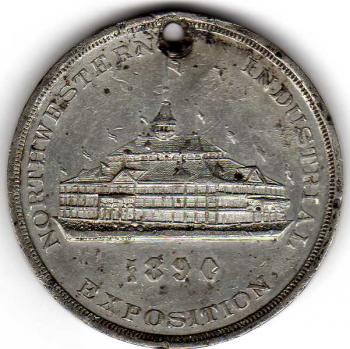|
J. William T. "Bill" Youngs, The Fair and the Falls: Spokane’s Expo ’74: Transforming an American Environment, Chapter Four
|
"Spokane Falls 1890" courtesy of the Washington State Archives
|
Chapter Four: "The World's Fair of the Northwest"
|
SummaryHaving survived the great fire of 1889, Spokanites set about celebrating the success of their new city by hosting an exposition the next year. Exhibitors were primarily from the Northwest and focused on promoting the region's natural resources and businesses. In sharp contrast to Expo '74, the Northwestern Industrial Exposition, as it was called, showcased the triumph of industry over the wilderness and its native inhabitants.
|
Author reads from the Text
"The chronicle of great fairs"
Judge William H. Calkins of Tacoma, the keynote speaker on the opening day of the Northwestern Industrial Exposition, "provided Spokane with a brief history of expositions in the Western world. Such fairs, he said, 'are the outgrowth of the business energy of this busy age, but their inception dates back to remote antiquity.' He mentioned fairs in ancient Rome and medieval Britain, but gave special attention to modern France. 'In various ways,' he said, 'France has kept alive these exhibitions, until they have become international in character and world-wide in reputation.' American fairs, Calkins said, originated in early New England, where 'it was usual for the tradespeople of the towns to display their products in a rude but interesting way at their principal towns.' These grew into county and state fairs 'and finally culminated in the centennial exhibition held in the city of Philadelphia during the summer of 1876.' Calkins mentioned other cities and their expositions, and then turned to the present fair. In the exposition hall on the banks of the Spokane River, the chronicle of great fairs would have a new chapter: London, Paris, New York, and now -- Spokane Falls."
"A new world"
"On the Spokane River bank in 1880, you would have seen a sight the Indians had known long before James Glover came to Spokane. Return to the same spot just ten years later, and you would see a new world. Bridges spanned the river and connected islets to the shore. Union Pacific tracks ran right beside the falls. Flumes pushed into the current, diverting the water into flour mills, sawmills, and hydro-electric plants. Trees were cut back to make way for buildings. Fill dirt had eliminated at least one of the river channels. Piles of lumber lay along the shore, and the floor of one sawmill extended from the south bank of the river to Havermale Island, hiding the southern-most channel."
"Geographical amnesia"
"One of the fair's most popular exhibits was a model of the Spokane River. J. W. Wentworth, a clothing merchant, advertised his wares by constructing 'an enormous pool of water representing the river.' Spanning the river was a model bridge "built out of shirts, collars, and cuffs.' This creation represented the new steel bridge then under construction at Monroe Street, which would replace a wooden one destroyed in the fire of 1889. Even though the scenery depicted by the model was only a mile away, the Wentworth reconstruction was more fanciful than real. In reality, Monroe Street is at the base of the turbulent lower falls of the river, but the model showed a placid waterway upon which floated a ship and a steamer described as 'towing two barges laden with merchandise.' The image grew from the commercialism of the age, not from any realistic appreciation of Spokane Falls.
"In such ways, the harnessing of the falls led to a kind of geographical amnesia, the loss of a compelling vision of the river. In a sense, the falls were conquered, then forgotten. The Northwestern Industrial Exposition of 1890 was the celebration of that triumph."
"In such ways, the harnessing of the falls led to a kind of geographical amnesia, the loss of a compelling vision of the river. In a sense, the falls were conquered, then forgotten. The Northwestern Industrial Exposition of 1890 was the celebration of that triumph."

